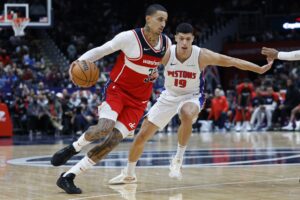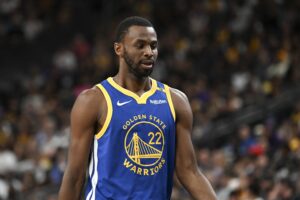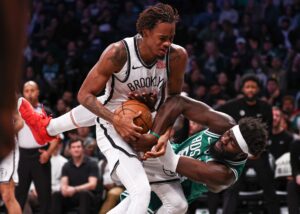As the 2016 calendar year comes to an end, the LWOS MC50 series captures the 50 most captivating athletes from 2016 in each sport. For LWOPB, we take a look at the 50 NBA players who drew headlines this past year, whether it be for on court accomplishments, off-season drama, or happenings off the court.
Here, we break down the fifth and final set of the most captivating NBA players of 2016. From all of us at LWOS, we wish you a happy New Year.
Most Captivating NBA Players of 2016: Part 5
Harrison Barnes
Harrison Barnes’ 2016 calendar year was fascinating and captivating for several reasons. He started off the year with a bang, averaging a career high 11.7 points while playing over 30 minutes per game in a starting role for the Golden State Warriors. This would seem quite average, but that Warriors team broke the NBA record for regular season wins, finishing 73-9. Because of that, Barnes’ contributions to the team were pretty meaningful. His playoff performance, however, was atrocious. Barnes shot just 35.2 percent from the field and 31 percent from beyond the arc in the NBA Finals, failing to convert on countless open shots as LeBron James led the Cleveland Cavaliers to three straight wins (after trailing 3-1) and their first ever NBA championship.
After the 2015-16 season ended, the Warriors signed Kevin Durant, effectively tossing Barnes aside. Reports even surfaced that Barnes’ former teammates had been recruiting Durant mid-season, meaning that they were already prepared to replace Barnes. But despite Barnes’ poor Finals performance, Mark Cuban’s Dallas Mavericks offered him a four-year, $95 million contract, which he signed as a restricted free agent. After Durant committed to the Warriors, Barnes was free to officially leave to Dallas.
Barnes’ 2016-17 Season
Though the Mavericks have struggled as a team thus far in the 2016-17 season, residing at the bottom of the Western Conference standings, Barnes has thrived. He’s averaging 20.4 points and 5.5 rebounds per game going into 2017, both career highs. The scoring average is nearly double his previous single-season high, yet he’s maintained his stellar mark of 46.6 percent from the field. Furthermore, Barnes has taken a ton of shots in isolation, to an incredible extent. Barnes has used a higher percentage of his possessions in isolation than any other player in the NBA – more than stars such as James Harden and Carmelo Anthony. This development is especially fascinating when considering the fact that most of Barnes’ shot attempts were catch-and-shoots or pull-up jumpers in Golden State. He has completely changed his game in Dallas, but it’s worked well so far.
Dwight Howard
After having great success with the Orlando Magic, Dwight Howard has declined every year since he left. The three-time Defensive Player of the Year struggled in 2016. He ended the 2015-16 season on a sour note, feuding with James Harden in Houston before his eventual departure. In the playoffs, the Rockets quite literally looked like they didn’t want to be there, and the Warriors promptly knocked them out in the first round. After that, Howard opted out of the final year of his contract, becoming an unrestricted free agent. He signed a three-year, $70.5 million deal with his hometown team, the Atlanta Hawks.
Although Howard is a shell of his former self, he is still a valuable player. Beyond that, he’s an incredible physical specimen, making him captivating to watch in any given game. Sure, he might have more bad games than one would want from a player making $23 million annually, but Howard is still fascinating to observe while he’s on the court. Oh, and he has amazing shoulders.
But after more than 12 NBA seasons, Howard’s biggest flaw is still his inability to make free throws. He’s just 53.2 percent from the line this season. Hack-a-Howard is sometimes captivating in its own way, though.
Andre Drummond
Speaking of free throw woes…
Andre Drummond is the worst free throw shooter in NBA history, at just 38.5 percent for his career. It’s not like he’s improved much over the course of it, either; he’s 44.2 percent from the line this season. In January, Drummond set the NBA record for missed free throws in a game, chucking 23 bricks (while making 13 of his 36 attempts). The Rockets took the hack-a-player strategy to the furthest extent, attacking Drummond’s most glaring weakness in a boring yet eye-popping experiment.
Besides missing free throws, Drummond is known for his dominance on the glass, as he led the league at 14.8 rebounds per game in the 2015-16 season. His inside presence helped the Detroit Pistons make their first playoff appearance since 2009. Drummond’s hard rolls to the rim make for a fun pick-and-roll chemistry with Pistons point guard Reggie Jackson. The big man is often on the receiving end of lobs like these:
That type of play is always a welcome sight.
Chris Paul
There aren’t many NBA players more captivating than Chris Paul. He’s been in the MVP conversation nearly every year since 2008. Paul is the orchestrator of “Lob City”, running one of the league’s best and most exciting offenses for the L.A. Clippers. He makes everyone around him better, and he creates plenty of dunk opportunities for Blake Griffin and DeAndre Jordan. Paul is masterful at his craft, and his ball handling and passing skills are fascinating to watch. From nifty crossovers to sweet passes that no one else saw coming, Paul is certainly one of the most captivating NBA players. Check out this two minute sequence of Paul’s artistry, for example, in which he scores three times and picks up two assists – all while running the same play five straight times:
Paul is possibly the most intelligent and crafty NBA superstar, and he’s easily a top ten player in the league.
Jimmy Butler
Ah, Jimmy G. Buckets. While Jimmy Butler is best known for his stellar defense, he’s become quite the offensive player. In fact, he’s now one of the more entertaining players to watch. To see an example of that, look no further than the first week of 2016, when Butler scored 42 points against the Toronto Raptors on January 3rd.
The most amazing thing about that performance, of course, was that Butler scored 40 points in the second half alone. He broke Michael Jordan’s record for the Chicago Bulls, in terms of points in a half. The ‘G’ does indeed stand for ‘gets’, Mr. Butler.
Early on in the 2016-17 season, Butler got back to work, playing better than ever and forming an electrifying chemistry with his new partner on the wing, Dwyane Wade:
https://www.youtube.com/watch?v=cQDB2J0xccc
If the dynamic wing duo can improve upon their play in the new year, the Bulls may be able to make some noise in the playoffs.
Myles Turner
Myles Turner proved to be one of the best rookies in the 2015-16 season. He was also a quite captivating player. Just a few weeks into the 2016 calendar year, Turner dropped 31 points on national T.V. against the Warriors, giving us a glimpse of his incredible potential:
https://www.youtube.com/watch?v=2Jtq2mM51eA
Turner is already a near-elite shot blocker and a great presence in the paint. His defensive prowess was on full display in the Pacers’ seven-game first round playoff series against the Raptors, in which Turner averaged 3.3 blocks in about 28 minutes per game. He’s already well on his way to becoming a force on the defensive end.
On the other side of the ball, Turner has also shown flashes of brilliance, such as that Warriors game. He’s even trying to become one of the many young ‘stretch fives’ in the league. Turner attempted just 14 three-pointers in his rookie season, connecting on a paltry three of those. But this season, he’s already taken 52 and made 19, good for 36.5 percent from deep – above league average. Turner is quickly developing into a dangerous threat next to Paul George, with the rare ability to both block shots and make triples on the other end.
Kevin Garnett
I already wrote my thoughts on Kevin Garnett’s retirement here, but there’s a bit more to this story. Garnett’s retirement was undoubtedly one of the most captivating storylines of 2016, and the Big Ticket will be missed. His on-court play, though – despite not really being there in 2016 – was most definitely captivating throughout his career. KG was known for his incessant, almost insane trash talking on the court. In 2016, he took that to the NBA on TNT studios, where he has a ‘cuss button’ in his Area 21 segment.
Garnett always managed to back up his talk while on the court. The defensive intensity and energy that he brought to the game were always in a class of their own. That separated Garnett from everyone else, and it made him a uniquely captivating player.
The acquisition of Garnett completely changed the Boston Celtics’ culture, leading to a championship in his first season with the team. Perhaps no other player could have an impact that profound, simply through his demeanor and work ethic. In 2016, Garnett wasn’t on a playoff team, but he was at least able to mentor the Minnesota Timberwolves’ young studs – Zach LaVine, Andrew Wiggins, and especially Karl-Anthony Towns.
Kyle Lowry
Kyle Lowry is one of the best point guards in the league. He led the Raptors to their first ever Conference Finals appearance last season. Lowry is truly a star, on par with players such as Kyrie Irving and John Wall this season. However, Lowry stands out for reasons besides his fantastic play and career high scoring average of over 22 points per game.
Lowry is listed at 6’1”, but he’s probably more like 5’11”. He’s not much of a high jumper, nor is he particularly fast compared to the likes of Wall and Russell Westbrook. But despite his physical limitations, Lowry hustles. Lowry dives for loose balls, takes charges (he’s tied for seventh in the league with nine charges drawn), and works his tail off. He does everything in his power to help the Raptors win games, and his budding ‘bromance’ with fellow All-Star and teammate DeMar DeRozan makes him one of the most fun players to follow off the court, as well.
Lowry’s work ethic and leadership helped bring the Raptors to new heights in 2016. Despite some shooting struggles in the playoffs, Lowry came through for his team when it needed him most. He put on one of the best individual performances ever by a Raptor in the deciding Game 7 of their second round series, ultimately leading the team to victory in a captivating display.
Timofey Mozgov
Timofey Mozgov is a tall human. According to his former teammate LeBron James, he’s “a big motherf—-r”. Mozgov’s presence on the court, as a lumbering giant, is rather awkward. What made him captivating in 2016, though, was the talk that surrounded him in the off-season. After being benched for most of the Cavs’ playoff run, Mozgov became a free agent. To the shock of nearly the entire basketball world, the Los Angeles Lakers decided to pay Mozgov big money. In this case, “big” meant Mozgov-sized big. The Lakers handed him a four-year, $72 million contract, which Mozgov signed to become their new starting center.
Mozgov’s deal had NBA fans buzzing early in the off-season, as no one truly knew just how much the salary cap jump would affect contracts until he got paid. Later in July, players such as Allen Crabbe and Joakim Noah signed similar contracts, making Mozgov’s deal seem less awful than people initially thought. Nearly halfway through the 2016-17 season, it seems that Luol Deng’s contract is actually worse for the Lakers. That’s not exactly what Lakers fans would like to hear, but surely they’re glad that the team didn’t sign Noah instead.
Kevin Love
After never quite fitting in with the Cavs in his first two seasons as the third wheel to James and Irving, Kevin Love hit his lowest point after Game 4 of the 2016 Finals. The Cavs got blown out in the first two games, and Love was picked apart by media members and fans alike. The Warriors had exposed him as a defensive liability, and the Cavs were better off with him on the bench, the thinking went.
Things didn’t get better from there. Love suffered a concussion, missing Game 3 of the Finals. The Cavs went on to win that game by 30 points, reinforcing the belief that Love’s presence was a net negative for Cleveland. In Game 4, Love came off the bench and the Cavs lost again, falling into a 3-1 hole in the series. But then a funny thing happened. Draymond Green was suspended for trying to punch James in the nether region, and Love started Game 5. While Love only scored 2 points in that game, he provided the Cavs with ample spacing, evident in his +18 plus-minus rating. His presence as a shooting threat freed up James and Irving to drive the lanes, as they each scored over 40 points in the win.
The team returned home to win Game 6, despite another quiet performance for Love; he played less than 12 minutes, possibly suffering from more concussion symptoms. Meanwhile, Richard Jefferson played big minutes for the Cavs, making fans scratch their heads about what Love’s role would be in the deciding Game 7.
“The Stop”
It was that final game, though, in which Love had his most captivating performance. He played over 30 minutes, with a +19 plus-minus. The power forward had 14 rebounds, providing the Cavs with a crucial interior presence alongside Tristan Thompson. But most importantly, Love managed to overcome his biggest weakness, when it came down to the most important possession of his basketball career:
https://www.youtube.com/watch?v=5Kil_Ugzezk
Love stuck with the NBA’s back-to-back MVP, Stephen Curry, through numerous crossover moves and attempts to get an open three-point look. Despite Curry’s best efforts, Love hung tight, and he managed to force Curry into taking a difficult shot that rimmed out, putting the Cavs in position to make it a two-possession game with their next shot. LeBron James made a free throw on the ensuing possession, eventually clinching the title for Cleveland. Love was a hero, with a defensive stop shockingly becoming the signature play of his career – “The Stop”. He was later praised by fans and media, and Love’s status with the Cavs hasn’t been questioned since.
After a celebratory off-season, Love got into great basketball shape, which injuries had prevented him from doing in the past couple of seasons. Over the last few months of 2016 – and the first few months of the 2016-17 season – Love has looked rejuvenated, playing his best basketball since his Minnesota days. He’s averaging about 22 points and 11 rebounds per game, while shooting above 40 percent from beyond the arc on a career high 6.8 three-point attempts per game. Love continuing his strong play will be crucial to the Cavs’ quest to repeat with a championship in 2017.
All stats are current as of Friday, December 30th, 2016 before play.
Main Photo:






